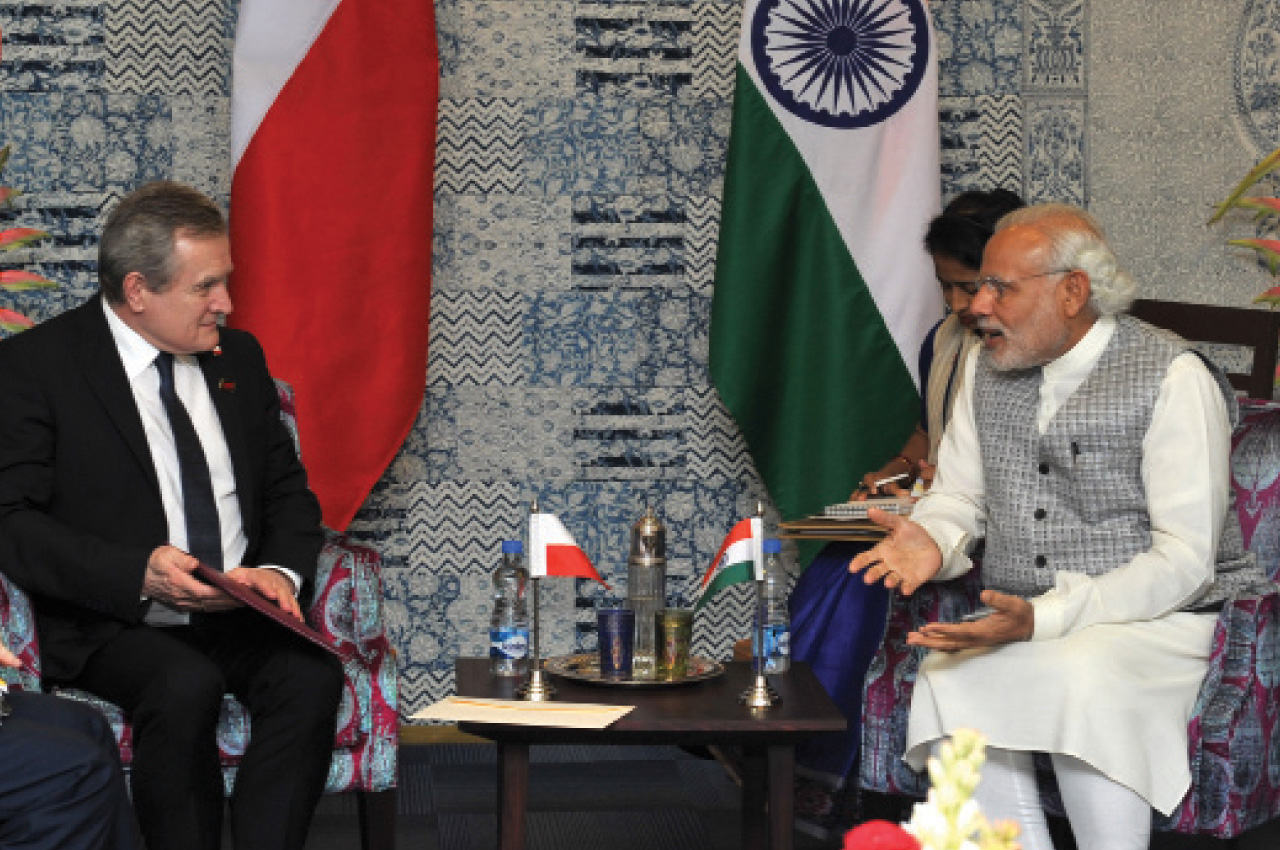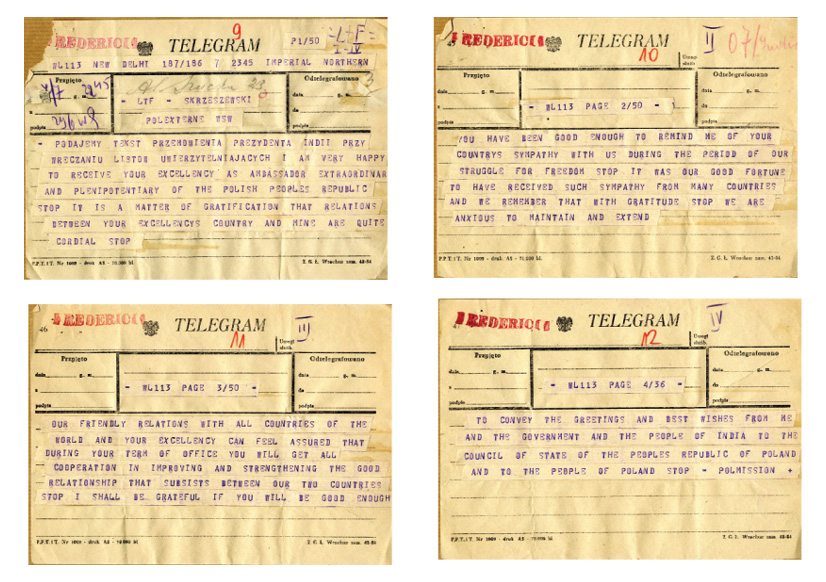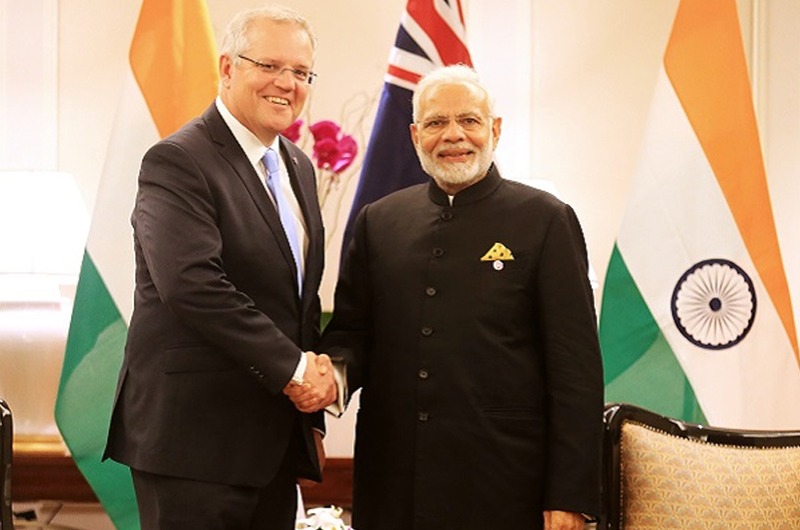Dr Sheetal Sharma
 “I am very happy to receive your Excellency Ambassador Extraordinary and Plenipotentiary of the Polish Peoples Republic. It is a matter of gratification that relations between your Excellency’s country and mine are quite cordial. You have been good enough to remind me of your country’s sympathy with us during the period of our struggle for freedom. It was our good fortune to have received such sympathy from many countries and we remember that with gratitude. We are anxious to maintain and extend our friendly relations with all countries of the world and your excellency can feel assured that during your term of office you will get all cooperation in improving and strengthening the good relationship that subsists between our two countries. I shall be grateful if you will be good enough to convey the greetings and best wishes from me and the government and the people of India to the Council of State of the Peoples Republic of Poland and to the people of Poland.”
“I am very happy to receive your Excellency Ambassador Extraordinary and Plenipotentiary of the Polish Peoples Republic. It is a matter of gratification that relations between your Excellency’s country and mine are quite cordial. You have been good enough to remind me of your country’s sympathy with us during the period of our struggle for freedom. It was our good fortune to have received such sympathy from many countries and we remember that with gratitude. We are anxious to maintain and extend our friendly relations with all countries of the world and your excellency can feel assured that during your term of office you will get all cooperation in improving and strengthening the good relationship that subsists between our two countries. I shall be grateful if you will be good enough to convey the greetings and best wishes from me and the government and the people of India to the Council of State of the Peoples Republic of Poland and to the people of Poland.”
The speech delivered by Dr Rajendra Prasad, the then President of India, on the appointment of Jerzy Grudzinski as the first Polish ambassador to India is indicative of the warm, cordial and friendly relations that India has with Poland right from the beginning of formal relations, which both countries have sustained for past several decades.
Prior to World War II, there were a Polish consulate in Bombay (established in 1933) and honorary consulate in Calcutta (1935). The consulate in Bombay came to play an increasingly important role during the Second World War (from 1939-45 as a Consulate General). Its main mission was to provide help for Polish refugees, mainly children who ended up in India due to wartime turmoil. After India gained independence in 1947, in the postwar period, the Ministry of Shipping, Poland, proposed to establish relations with India. In 1952, the Ministry underlined “the development of Polish shipping interests” in India and emphasized the need to establish diplomatic outposts or consulates in India. The Ministry of Foreign Trade in Poland was of a similar opinion. In 1953, it planned to “delegate a representative to Hindustan […] in the capacity of the Head of Economic Mission”. Formal relations between India and Poland were finally established on the March 30, 1954. The newly appointed ambassador, Jerzy Grudziski, arrived in India at the end of June 1954, where he opened an office at the Imperial Hotel. Credential letters were presented on July 7, 1954. India, for its part, extended the accreditation of its ambassador in Moscow, and the embassy was initially located in Warsaw’s Bristol Hotel. The development of bilateral relations in the 1950s (including a visit to Poland by the first Prime Minister of India Pt. Jawaharlal Nehru in 1955) led to the expansion and deepening of the network of Polish outposts and establishment of consulates in Calcutta and Bombay, in 1960.

Interestingly, the relations and contact between India and Poland can be traced backed to several centuries. As early as 15th century, a small number of Polish writers, nobility, statesmen, merchants, soldiers and missionaries visited India. One of the earliest recorded account is of Pawel Palczowski of Palczowic (Polish nobleman and statesman from the distinguished senior Silesian Polish nobility House of Saszowski family), the Polish merchant Gaspar da Gama from Pozna, and of Krzysztof Pawlowski who provided the first description of India in Polish, recorded in a letter dated 1569. These accounts are impressive and their description of Indian culture, history, society and literature generated interest about India in Poland. As a result, a lot was mentioned about India in Polish language and literature. During the 19th century, several Sanskrit classics were translated into Polish. Yet another important work in Polish was titled as “History of Ancient India” that described about Indian history, culture and social structure, and it was one of the first of this kind that was published in Europe. Gradually research and teaching in Indian languages and literature began in the Universities of Kraków, Warsaw, Wrocław and Pozna. There was regular exchange of ideas between writers, artists, painters and designers. At the beginning of the 20th century, Maharaja of Jodhpur had commissioned the Polish painter Norblin to decorate the Umaid Bhavan Palace. During the Second World War, the then Jam Sahib of Nawanagar had extended hospitality to some 6,000 Poles, mainly orphans released from Siberia. The survivors have formed the World Association of Poles from India. Despite their advancing years, the members of the Association had donated funds for relief and rehabilitation after the Gujarat earthquake in January 2001, and continue to visit India frequently.
In 2014, Poland and India celebrated the 60th anniversary of the establishment of diplomatic ties between the two countries. H.E. Prof. Piotr Klodkowski, Ambassador of the Republic of Poland to India highlighted the special relationship between the two countries on its 60th anniversary. The Ambassador said, “Poland and India officially established diplomatic relations in 1954 but our cultural bonds should be dated back much earlier. In fact, as early as 1893 the Chair of Sanskrit at the Jagiellonian University in Krakow was established which introduced scholarly research on India. At present the pillars of our cooperation are very stable and well defined. Our shared interests in the energy sector , our long-lasting military ties, and collaboration in the defence industry, point to significant cross-cultural diplomatic exchanges that have formed the bedrock of Indo-Polish ties. In the realm of culture, excellent links and growing mutual artistic inspirations are our best assets in the strengthening of bilateral relations”.
Polish economy has performed very well in the last decade despite the global recession in general and euro zone crisis in particular. In the year 2009, Poland was the only state in the EU to register a 1.8 percent GDP growth. Among the new countries that joined the EU the most developed country, in terms of per capita GDP, is the Czech Republic, followed by Slovakia, Hungary, and Poland. Although Poland’s per capita GDP is the lowest amongst these four countries from the CEE, the Polish economy is the biggest economy in the region.
Indian exports to Poland between 14-07-2015 to 14-07-2016 was around 0.4 percent of total India’s exports valued at $739.84 million and total shipments were 143684. India’s exports to Poland in Jun-2016 has expanded to $3.4 million an increase of 5.38 percent compared to May-2016. Total export value for Poland in Jun-2016 was $ 63.32 million, and total export value for Poland in May-2016 was $59.91 million. India exports more to Poland as compared to imports. Some of the main products exported from India include cotton, textiles, chemical products, vehicles and vessels. The products that India imports from Poland are electromechanical appliances, mineral and chemical products, among other items. Indian investments in Poland are valued at over $3 billion and include ArcelorMittal (global Luxembourg-based investment), Videocon, Escorts, Strides Arcolab, Reliance Industries, Ranbaxy, Essel Propack, KPIT Cummins, Zensar Technologies Ltd, Infosys and Wipro, Jindal Stainless, Berger Paints India, UFLEX, Glenmark Pharmaceuticals, Flemingo Duty Free, Rishabh Instruments. The Polish companies that operate in India include Torunskie Zaklady Materialow Opatrunkowych (TZMO) in Dindigul (manufacturing hygiene sanitary products) Can-Pack Poland in Aurangabad (manufacturing metal packaging), Inglot (cosmetic products), and Geofyzika (seismic surveys for oil companies).
Poland expects its trade volume with India to grow to $4 billion by 2020 from $2 billion now and wants its companies to expand collaboration with local companies in a host of sectors. Polish companies are keen to collaborate with domestic firms in India in the major sectors like IT, coal, food processing, power, petrochemicals, defence, science and technology. Many of the leading domestic IT firms like Wipro, Infosys and HCL already have a presence in the eastern European country. There is lot of scope for both India and Poland to cooperated in sectors like IT/ICT, coal, food processing, power and energy, petrochemicals, chemicals, defence, science and technology. Moreover there is lot of potential for Polish firms to engage with India in various initiatives launched by PM Sh. Narendra Modi, such as Make in India, Smart Cities, Digitial India etc. In March 2015, the Make in India campaign was formally launched in Warsaw. It is interesting to note that in response to India’s initiative, Poland’s Deputy Prime Minister Piechocinski, announced a ‘Go India’ programme in April 2015, that will facilitate and incentivise Polish companies to engage with India.
Although there are only approximately 3000 members of Indian community in Poland however the cultural links are deep. Yoga day is celebrated with much enthusiasm. The 2nd International Conference on Yoga and Ayurveda (June 26 to 28, 2015) was held in Sulislaw, Opole region. Starting of a Diploma course in Yoga and Ayurveda was also announced on the occasion. A strong tradition of Indology studies has been sustained in Poland for centuries. The Jagiellonian University has an active Indology Department with a popular 5-year post-graduate course in Indology. Hindi language is also taught and is very popular. The Indology Department of the Oriental Institute at the University of Warsaw (established in 1932) is one of the main Centres for Indian studies. ICCR funds two Indian professors, who teach Hindi and Tamil at the Warsaw University and Tamil at the Jagiellonian University. The Indian Embassy in Warsaw also regularly organizes Indian cultural programmes in Poland with the help of ICCR. The Embassy also offers scholarships to Polish professionals under the Indian Technical and Economic Cooperation (ITEC) programme to Polish students under ICCR and Kendriya Hindi Sansanthan, Agra, scholarship schemes. There are various MoUs and Agreements between universities and educational institutions between the two countries for exchange of scholars and students.
India and Poland are in contact with centuries now. Formal relations between the two countries have strengthened the bonding. There is lot of scope for both the nations to meaningfully engage with each other to flourish economically and help each other in fulfilling mutual interests and goals of development.








